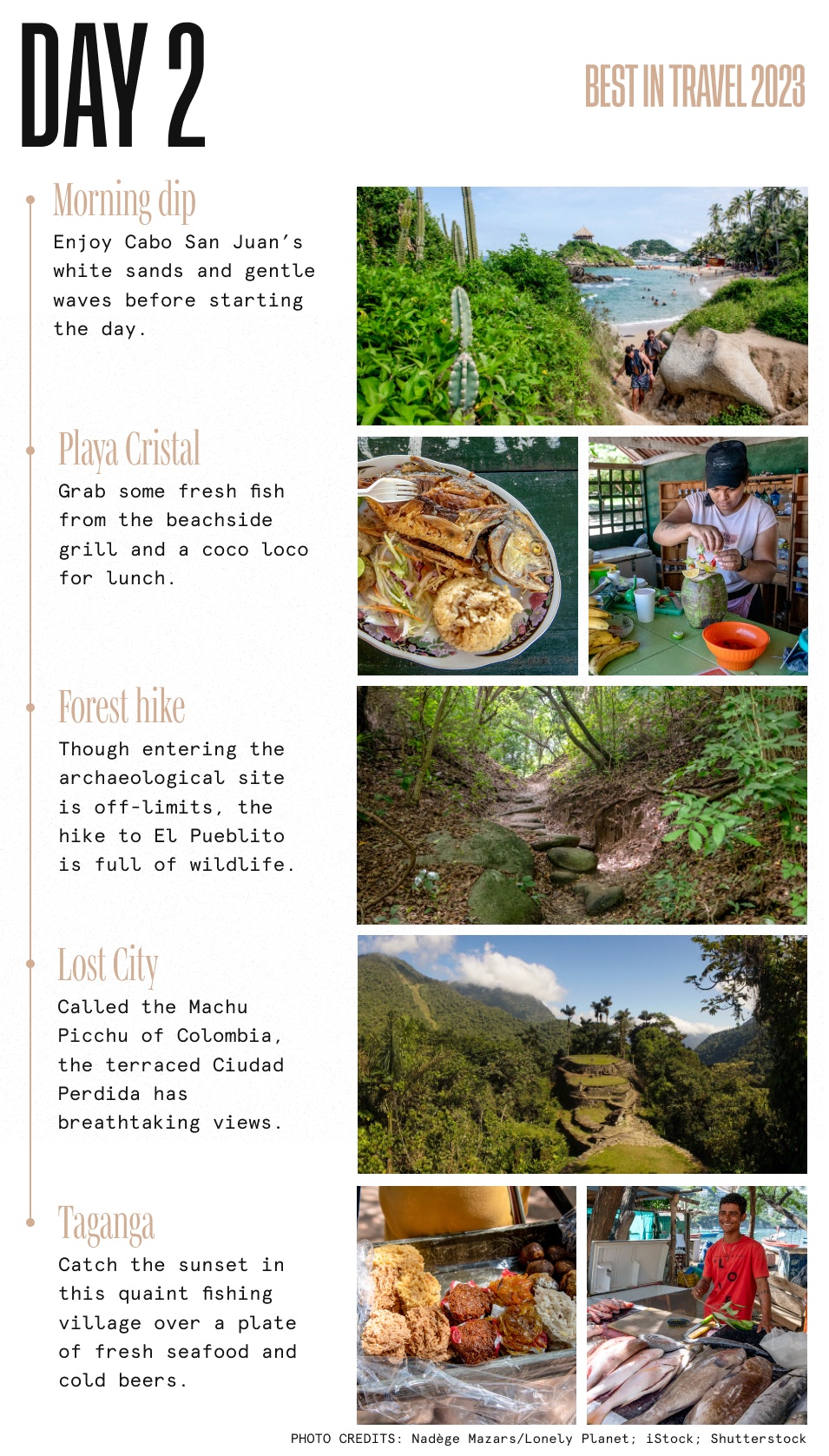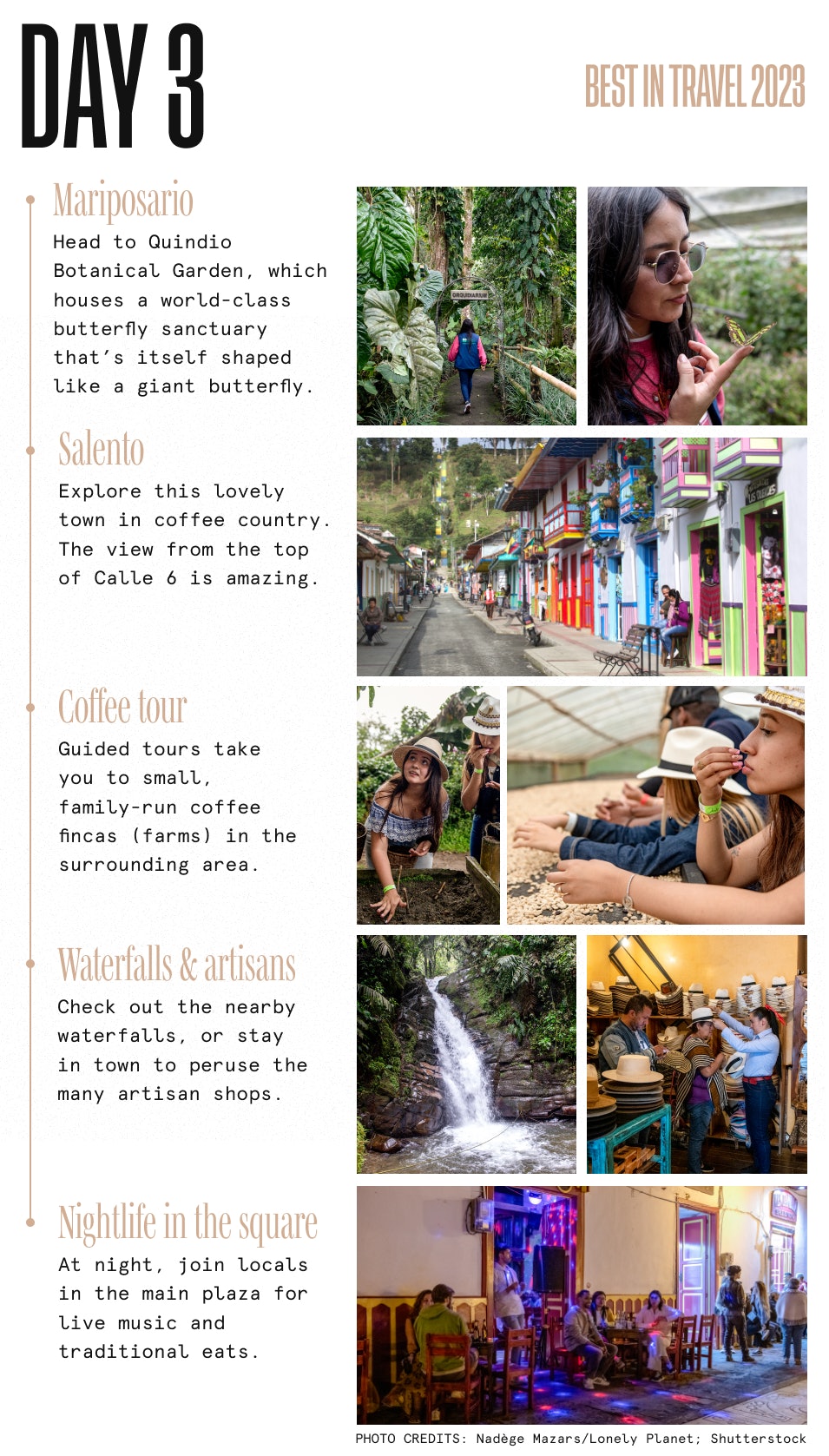
The 30 best countries, cities and regions to visit in 2025

Hikers on the way to Corcora Valley © Nadege Mazars/Lonely Planet
From the beauty of the beaches of Parque Nacional Natural Tayrona to the peaks of Parque Nacional Natural Los Nevados, Colombia’s 59 protected natural areas are a must for nature lovers.
Along with protecting some of the most biologically diverse ecosystems in the world, 26 of these areas are also inhabited by indigenous and Afro-Colombian communities.
Ocean Malandra shows how to visit two different parks over four days in Colombia.

I’m a nature-loving, salsa-dancing, coffee-gulping, freelance travel/food writer and environmental journalist from Northern California who’s been traveling in Latin America for over 20 years. I’ve lived everywhere from Rio de Janeiro to Mexico City but am now based in Bogotá, Colombia, where I am the author of the Moon Guide series to this amazing country and an editor of an anthology on plant medicines. I’m currently at work on a memoir-style narrative non-fiction book based on my adventures here.

When it comes to natural splendor, Colombia is in a league of its own. It boasts Caribbean beaches, high Andean peaks, the deep Amazon rainforest, arid coastal deserts and much more – in fact, it holds the record as the world’s most biodiverse country per square foot. That’s why the 59 glorious parks that make up the country’s National Natural Park System (PNN) collectively add up to an outdoor-travel offering without equal on earth. In this four-day itinerary, we’ll only have time for two highlights of this unparalleled park network: Parque Nacional Natural Tayrona and the Valle de Cocora. Yet this dynamic duo will take you through two completely different ecosystems and cultural regions that will surely leave you begging for more.

Begin your journey in Santa Marta, a medium-sized city sitting pretty in a gorgeous bay right next to Parque Nacional Natural Tayrona. This rugged slice of Caribbean wilderness occupies the lower reaches of the largest coastal mountain system in the world, the Sierra Nevada de Santa Marta. Its unique topography – with jungle-covered mountains descending steeply to turquoise seas – gives the park rugged features and cove beaches quite unlike any other part of the Caribbean shoreline in Latin America.
Begin your day with breakfast at Ikaro, located on a pedestrian-only street in the pretty Colonial historic core of Santa Marta, the oldest city in all of South America. Enjoy an organic coffee (made from beans grown in the nearby Sierras), omelet and açai bowl in a cool jungle-like setting with a living wall and outdoor planters. Next, take a walk down to lush Parque de Los Novios and onto the Santa Marta malecón for a panoramic view over the boat-filled bay and harbor, where local kids like to splash in the surf.
This is also a great place to catch a taxi to the Santa Marta market (10 minutes; no more than $6). Here, you can stock up on fresh fruit and whatever other foods you will eat inside the park outside of the menu at its beachfront restaurant. Buses to Tayrona run from a small terminal behind the market every half hour, dropping you off at El Zaino, the park’s main entrance (45 minutes; $5). It’s a good idea to depart as early as you can, as the coast heats up by midday and you want to set out on your hike as early as possible.
At El Zaino (where there’s also a parking lot for those who arrive by car), you must pay an admission fee to enter the park ($15). You can then walk or take the collectivo bus to the coastline and the first set of camping sites within the park, at Canaveral. Those with limited time can spend the night here in an ecohab, lodgings modeled after the thatched-roof houses of the ancient Tayrona civilization that sport amazing views out over the Caribbean Sea. Yet (time allowing) it’s well worth it to hoof it down the coastal trail to other campsites like Arrecifes and (especially) Cabo San Juan. You’ll find a variety of camping options within the park, from cabanas to tents for rent, and you can also pack your own gear if you prefer a DIY setup.
The two-hour hike between Canaveral and Cabo San Juan takes you through thick tropical rainforest and past several spectacular viewpoints over the turquoise sea; be on the lookout for exotic wildlife like tamarin monkeys and green iguanas. Once at Cabo San Juan, you can rent a tent or even a hammock over the gently lapping waves. The onsite restaurant served fresh local fish specialties like pargo (red snapper) and mojarra (perch) as well as shrimp cocktails.

Wake up to a swim in the crystalline waters of the Caribbean Sea, just steps from your tent, before filling up on a hearty breakfast at the onsite restaurant or whatever you packed in with you. Serious beach bums will want to head down the coast a bit to check out Playa Cristal, just east of Cabo San Juan, where a small protected bay creates bathtub-calm waters perfect for wading and snorkeling. Down the coast toward the west, the wilderness beach of Playa Brava (watch out for the very dangerous waves) gives way to the park’s only nude beach, Playa Nudista.
Another option is to head inland on a two-hour hike to El Pueblito, an archaeological site that once held a bustling Tayrona village. Expect to see tons of wildlife including iguanas and basilisks (lizards that run on the top of freshwater ponds and rivers!) on the way. Jaguars and howler monkeys also live here, the former almost never seen and the latter heard more often than actually viewed. This hike can also be done as a loop to or from Playa Brava; be sure to bring plenty of water and sunscreen as the entire journey will take four to five hours.
The Tayrona were an ancient advanced civilization whose descendants, the Kogi, live on in the higher reaches of the Sierra Nevada de Santa Marta and still actively manage the park. Much longer four-to-five-day treks to the larger, higher-up “Lost City” site can be organized from Santa Marta. Often called the Machu Picchu of Colombia, this terraced stone settlement was built around 800 CE and features several circular plazas with breathtaking views out over the jungle-covered mountains.
After grabbing lunch (either from the onsite restaurant or from your provisions), it’s time to head back to Santa Marta the same way you came. Try to make it to the fishing village of Taganga, just 15 minutes outside of Santa Marta by taxi or bus, to catch the sunset over the majestic cliff-lined bay. A row of simple waterfront restaurants serve fresh seafood plates based on whatever was caught that day. Grab a cold local beer or coco loco (coconut filled with rum) and unwind after your first national-park adventure.

Take an early-morning flight from Santa Marta or Cartagena to Armenia, the capital of the Quindío department, famous for its cultivation of top-shelf coffee. Armenia is also home to the Quindío Botanical Garden ($10), which houses a world-class, 680-sq-ft mariposario (butterfly sanctuary) that’s actually shaped like a giant butterfly. It’s home to almost 2000 butterfly species, including the giant, iridescent blue morpho and the transparently winged Greta oto.
Back in Armenia’s bus terminal, grab a bus for the hour-long ride to Salento (departures every 20 minutes; $5), which winds through the coffee region’s beautiful tropical-mountain scenery. One of the most beautiful pueblos in all of Colombia, Salento has a brightly painted and balcony-filled historic baroque core, centered by a lively plaza surrounded by cafes and restaurants.
Spend the afternoon taking in this traditional coffee town. It takes about 20 minutes to ascend to the mirador (lookout) off Calle 6 – with the reward a gorgeous panoramic view of the pueblo and the surrounding verdant mountains and coffee-farm-dotted landscapes.
We highly recommend a visit to a local coffee grower. A guided tour (which should be booked ahead of time) will take you to a small but premium family-run coffee finca (farm) in the surrounding area. There are also waterfalls to explore (just 10 minutes from town, the Santa Rita Falls are on a private reserve with hiking trails), plenty of artisan shops to peruse (the region is famous for its handmade woodwork) and charming little side streets to explore in this postcard-perfect mountain village. Whatever else you do in Salento, make sure you grab a cup of joe at Cafe Jesús Martín, run by the “man who saved Colombian coffee.” Years ago, Martín refused to export his best beans, instead roasting then serving them within an hour. This started a national trend – and today Martín is a Colombia legend.
At night, join the locals in the main plaza for some live guitar music from traveling bohemians, as well as traditional eats. The coffee region is famous for its arepas con queso (fat corn tortillas stuffed with cheese), and Salento in particular is known for its fresh lake trout, which you can enjoy either al allijo (cooked in garlic) or grilled to order. Share some aguardiente (sugarcane alcohol flavored with anise) with the locals, and they’ll steer you toward the best spot in town for an authentic dinner. But be sure to get a good night’s sleep as the next day is going to be a real workout.

Get up early to set out on the epic loop hike through the Valle de Cocora, a lush, tropical mountain valley that is part of the much larger Parque Nacional Natural Los Nevados. The valley is home to towering groves of the Quindío wax palm: growing to over 200 feet high and only existing within a small altitude range of 2000 to 3000 ft, these are the tallest palm trees on the planet – and Colombia’s national tree. The entire loop trail will take five to six hours, so wear good shoes and pack plenty of water to get you through.
From the main square in Salento, hop in a jeep (which leave as soon as they fill up; 30 minutes; $3) to the trailhead. Once on the trail, you’ll enter a wide-open valley with towering mountains on the horizon and small farms all around. This part of the trail is relatively flat and even and a great way to warm up for what lies ahead. You’ll need to pay a small fee (under $1) to enter this valley, plus another one at the end: much of this part of the trail is actually on private land.
About two miles in, you’ll leave the valley behind as the trail begins to climb up into the cloud forest–covered mountains. From here, it’s just under two hours of rough uphill hiking – through thick jungle, over footbridges that cross streams and past quaint farmhouses – to the finca at the end of the trail. Expect to see several glorious species of hummingbirds, many toucans and the fabulous yellow-eared parrot along the way. The park is also home to speckled bears, pumas and sloths: you’ll get a gold star if you spot any of these elusive (and dangerous!) creatures.
At Finca la Montaña, a spectacular view awaits – as well as refreshments and lunch (ask for the fresh locally caught trout), if you make it before 2pm or so. The trail down the other side of the mountain is for many the highlight of the trip: this is where you’ll walk underneath the mighty wax palms as they sway in the breeze, as small streams crisscross the verdant landscape. This section can also be done as a relatively quick in-and-out, starting at the end of the trail instead of the beginning. Take your time enjoying the beauty here before heading back to Salento for the night.
Want to head to Parques Nacionales Naturales de Colombia but wish there was someone to plan this out for you? Let Lonely Planet’s sister company Elsewhere take away some of the stress of planning by connecting you with the best local expert to craft your dream trip.
Plan with a local
